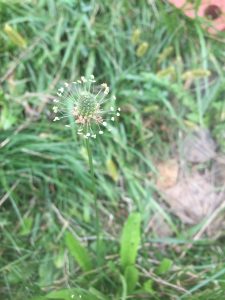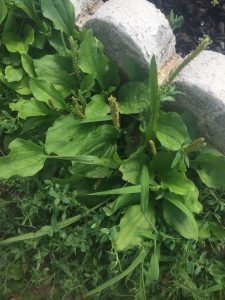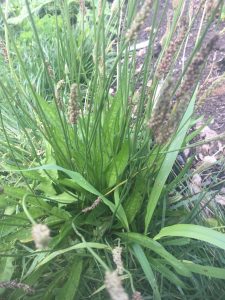(Plantago major, Plantago lanceolata)
Description
Not to be confused with the banana relative with the same name, Plantain species are low, sessile herbaceous plants. They are perennial with broad (P. major) or narrow (P. lanceolata) leaves arranged in a rosette with fibers running the length. The flowers and seeds are green and produced on stems up to 30 cm tall.

Cultivation Tips
Plantago species contain a tough taproot that allows them to thrive in highly compacted soils and withstand drought conditions. They are often found along roadsides and foot paths where the soil is poor and compacted. Plantago species grow fastest in full sun, but will grow even in moderate shade. While plantain is primarily wind pollinated, we have observed bees collecting pollen from the flowers and transferring it between plants. When the seed stalks are ripe the will turn from green to brown an release hundreds of tiny dark brown seeds, which can be planted immediately or collected and stored; they do not require stratification to germinate. Plantain sees very little pressure from pest and disease.
Uses
Plantain is one of the most widespread medicinal herbs, useful for treating wounds and inflammation [38] (see our recipe for an herbal salve), to aid in recovery from fever and respiratory infection [44], and to soothe sore throats [45].
Young plantain greens can be eaten raw in salads or cooked, but older greens are tougher and should be boiled or used in stews. The leaves are very high in vitamins and minerals [46]. The seeds, though edible as a flour substitute, are tedious to collect; we therefore recommend eating the entire fruiting stalk with multiple unripe seed pods while they are still green and tender.
The taproot makes plantain useful for remediating compacted soils, and is a great choice for an edible lawn.
Friends
Plantain makes a great ground cover plant in a perennial vegetable patch and will grow well among turf grasses, adding an extra layer of function and yields in grass pathways through the garden.

